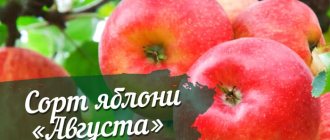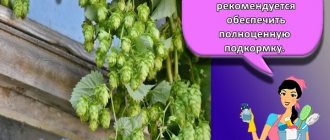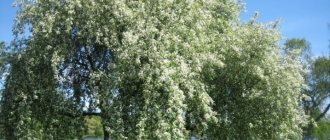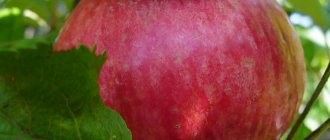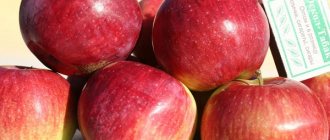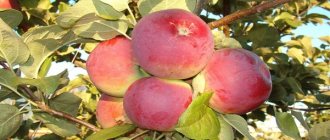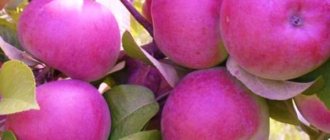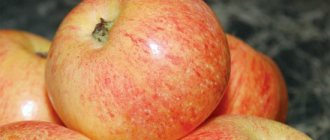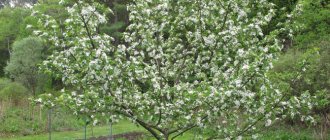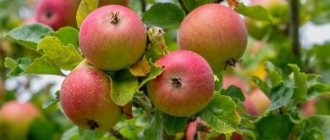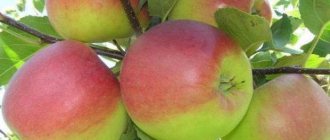At one time, I thought that I was quite good at apple trees. This was facilitated by the presence in our garden of many apple trees planted by my father.
He was an agronomist and garden lover. White filling, Borovinka, Snow Kalvil, Pepin Saffron. And there were 15 of them in total. And not one at a time. And 2-3. I did not know the exact names of other apple trees.
Jonathan was definitely not there. He gained popularity later. In the eighties, many gardeners sought to acquire and plant the Jonathan apple tree in their garden. And for good reason. It is now more trying to find his clones.
There are better opportunities. And more and more the temptation to plant new items from the apple assortment.
Apple variety Jonathan
Jonathan is an American apple variety with late winter ripening, selected in 1886 from the seedlings of the Esopus Spitzenburg variety. Other names for the apple tree are Winter red, Horoshavka winter, Oslamovskoe. This variety is very popular and most widespread in areas of industrial horticulture, but in the new plantings of recent years it is already noticeably less common. Since 1954, Jonathan has been zoned throughout Ukraine. However, in the climatic conditions of Russia, it is not winter-hardy enough, therefore, it is recommended for use by the State Register of varieties only in the North Caucasus region.
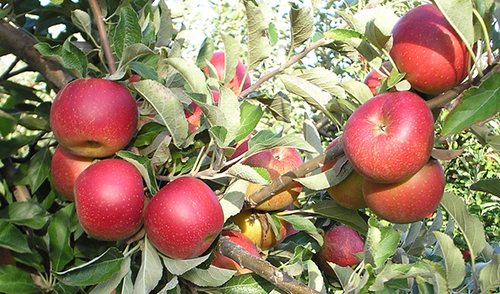
Trees of medium vigor, broadly rounded crown, slightly spreading, medium thickened. Skeletal branches of medium thickness form sharp corners with the trunk (from 35 to 75 degrees) and diverge at the ends to the sides. With age, the main branches take on a slightly drooping shape under the weight of the crop. The bark on the trunk and branches is brownish-greenish in color. Fruiting of a mixed type, fruit setting occurs mainly on ringlets, fruit twigs, spears and annual growths.
The kidneys have a moderate degree of excitability, the ability to shoot is high.
The shoots are greenish-brown in color, slightly geniculate and strongly pubescent, thin or medium in thickness. The leaves can be small or medium in size, the shape of the leaf is elongated-ovate, the edges are slightly raised, slightly wavy, with serrate-crenate serration. The surface of the leaf blade is dull, slightly wrinkled. A characteristic feature of the Jonathan apple tree is the color of its leaves - green, with a bluish-silvery bloom due to dense pubescence.
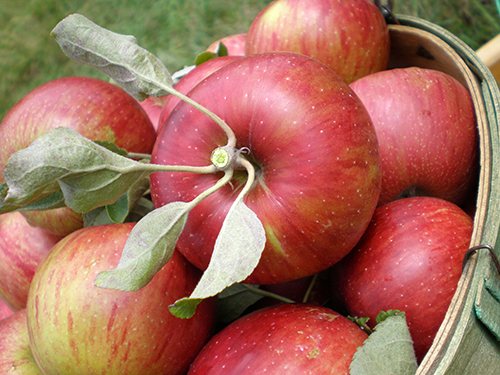

Abundant flowering occurs in mid-late periods. The pollen has an average viability (26 to 41%). With free pollination, from 16 to 32% of the fruits are tied. The following varieties are recognized as the best pollinators of the Jonathan apple tree: Golden Delicious, Idared, Mekintosh (Mackintosh), Spartan, Rubinovye Duki, Umanskoe Zimnee. The variety has a tendency to self-fertility: as a result of artificial self-pollination, from 5 to 7% of the fruits are tied, and with natural - from 2.5 to 3%.
Fruits are one-dimensional, medium-sized or larger, the weight of one apple can range from 105 to 150 grams. The fruits have a weakly flattened rounded or rounded-conical shape, the surface of the apples is even, sometimes slightly ribbed in the upper part, smooth, with a slight glossy sheen. The main color of apples is greenish-yellow, the integumentary color occupies almost the entire surface of the fruit in the form of an intense blurry or striped dark red blush. The subcutaneous dots are white, moderately or well visible on the skin; rustiness in the form of a "mesh" can rarely be found. The skin itself is quite thin, but at the same time dense and elastic. The stalks are thin, short or medium in length. The funnel is medium in width, rather deep, with rustiness.The saucer is usually deep, slightly folded, of medium width, and has almost vertical sides. Closed cup. The calyx tube is medium in width, often rather long, funnel-shaped. Seed chambers of a closed type.
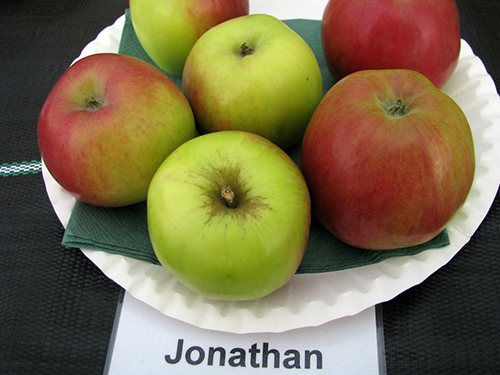

The flesh of the apples just removed from the trees is greenish-white, while the optimally ripened ones are light cream or light yellow, dense structure, with a pleasant aroma and very juicy. Apples have an excellent dessert, wine-sweet taste (basic sweet taste, sourness is barely caught). The taste score on a 5-point tasting scale is 4.4 - 4.5 points. In terms of chemical composition, the fruits of the Jonathan apple tree grown in southern Russia contain: dry matter (13.7%), the amount of sugars (from 10.6 to 11.3%), titratable acids (0.65%), ascorbic acid ( 6 mg / 100 g), P-active substances (100 mg / 100 g). In addition to fresh consumption, apples of this variety are often used for processing into jams and preserves, as well as for the manufacture of dry powders and bases for table wines.
The period of removable ripeness of fruits falls on the middle of September (second decade). In storage conditions, apples are stored until the end of February, in a refrigerator - usually until mid-April, to a maximum of May. During storage, apples can wither or become covered with a bitter "Jonathan" spot, most often this is caused by a violation of normal storage conditions. High transportability.
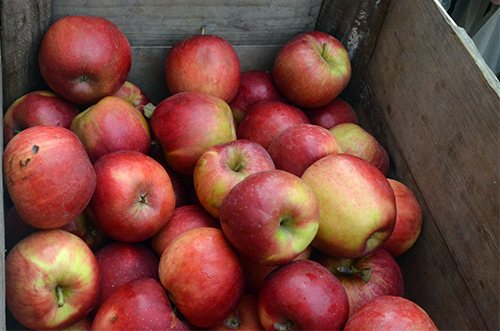

The variety is fast-growing, on medium-sized stocks of apple trees bear fruit from the 5th year. Fruiting is characterized by stability and generosity. Trees at the age of 5 - 6 years give about 15 - 18 kg of fruit, and 10 - 12-year-old apple trees can yield from 40 to 85 kg per tree. The maximum yield was recorded at the “Sad-Gigant” state farm: 490 kg of apples were harvested from individual trees. A decrease in the productivity of trees and shrinking of fruits can be observed when growing apple trees on insufficiently fertile soils and with a lack of moisture.
The level of winter hardiness of the variety is not high enough: with a significant decrease in temperature in the winter period, perennial wood freezing is observed.
Scab resistance is relatively high, but low resistance to powdery mildew.
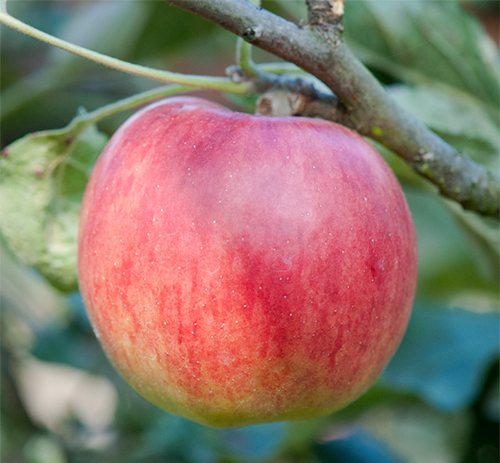

The variety is excellent for private gardens and commercial cultivation. Sunny locations are preferred for tree planting. The most suitable soil type is fertile loam and sandy loam.
The main advantages of the apple tree are: excellent taste of dessert-type fruits, high yield, early maturity.
Main disadvantages: severe damage by powdery mildew, insufficiently high level of winter hardiness, damage to fruits by spotting during storage.
Jonathan was actively used in his work by domestic and foreign breeders as an initial form. With his participation, about 40 new varieties were created (more than half abroad), including: Idared of the USA selection (Jonathan x Wagner), Memory of Sergeev of the selection of the SKZNIISiV (Jonathan x Anis Kubansky). Also, varieties immune to scab were bred: the Canadian McFree selection of the Ottawa Experimental Station (with the participation of Jonathan, Mekintosh, Rom Beauty, M. Floribunda 821) and the French Prime selection of the Angerskaya Experimental Station.
Pollinating trees
For a larger yield, the Jonathan apple tree needs to be placed next to other apple varieties. The best pollinators are:
- Golden Delicious.
- Idared.
- Mac.
- Spartan.
- Ruby Dooks.
- Umanskoe winter.
This variety also has a tendency to self-fertility. Thanks to artificial pollination, up to 7% of the crop is tied, and with natural - up to 3%.
Specifications
In addition to describing the tree, it is important to study the technical characteristics of the variety.For example, frost resistance, in what climatic conditions to grow, pollination and a number of other characteristics.
Optimal climatic conditions
It is recommended to plant a seedling of the Jonathan variety in the southern or central region. In northern latitudes, where frosts are severe, the tree will not be able to survive and will die due to the cold.
Frost resistant
Due to the weak bark, frost resistance is low. The apple tree is capable of surviving frosts down to -20 degrees.
In which areas is it possible to disembark
You can plant the Jonathan variety in any region where winters are mild or warm. Otherwise, there are no restrictions on the growing region. For some summer residents, even in the north, the apple tree survives winters.
Susceptibility to diseases and pests
The Jonathan hybrid has low immunity to powdery mildew. Medium resistance to scab and bacterial cancer. With proper care, the appearance of these diseases can be avoided.
Pollination and self-fertility
The Jonathan apple hybrid is self-fertile. To increase yields, pollinating apple trees are planted next to the tree:
- Spartan;
- Mac;
- Umanskoe winter.
Neighborhood with other apple trees will significantly increase the number of inflorescences and ovaries.
Ripening period of apples
Fruiting of the tree begins in the 5th year after planting the seedling. Fruits are harvested from mid-September to early October.
Harvesting and using the crop
It is recommended to pick apples before they fall to the ground. Jams, preserves, compotes are made from apples, used for baking.
Advantages and disadvantages
Gardeners highlight the following positive features of the Jonathan variety:
- unique aroma and taste of fruits;
- long shelf life of the crop;
- fast onset of fruiting, which is stable at the same time;
- apples are suitable for any kind of culinary processing;
- the productive period is long.
Naturally, this plant also has disadvantages that can significantly affect the desire to plant it on its own site:
- poor frost resistance;
- insufficient resistance to most pests and some diseases;
- the tree needs pollinators;
- the crop can only be stored in the cold, otherwise it will deteriorate.
Features of planting and growing
As you know, planting is an important stage in the formation of the future harvest. It is necessary to take into account all the pros and cons of autumn and spring planting of a seedling, planting technology and many other nuances.
Disembarkation
Before planting an apple tree seedling, prepare the tree and the soil. It is advisable to prepare the soil for planting in 2-3 weeks.
The soil is dug up, covered with manure, wood ash and mineral fertilizers. A stake is driven into the center of the pit.
The best time to plant a young tree
Saplings are planted twice a year - in spring and autumn. Most summer residents prefer autumn planting. During the winter, the seedling will have time to take root, and in the spring it will begin to grow with renewed vigor. Can be planted in spring if there is no other way out.
Preparation of young seedlings
Before planting, the rootstock of the seedling is soaked for 10 hours in a growth activator. Immediately before planting, the root system is dipped in a liquid clay solution and planting begins.
Planting scheme and depth
The distance between the trees is at least 4 m. It is important to plant the seedlings so that the crown does not interfere with other trees. It is recommended to plant an apple tree Jonathan at a depth of at least 1 m.Put the seedling in the center of the pit, cover it with soil and water it abundantly with warm water. Tie a tree to a stake.
Irrigation mode
Water the tree during the budding period. The second watering is during the formation of ovaries. The third time the apple tree is watered during fruiting. The fourth time - before preparing the apple tree for winter.
Fertilizer
Top dressing periods coincide with watering. At the beginning of the season, nitrogen and organic matter are introduced into the soil.In the second half, when the formation of ovaries begins, the soil is fertilized with phosphorus, potassium, manure, wood ash. Nitrogen should not be added to the soil before cold weather.
Pruning
Sanitary pruning is carried out annually in the fall. Remove dry and diseased branches. In the spring, part of the young branches is cut, leaving several skeletal branches and young shoots.
Preventive treatment
Bordeaux liquid or copper sulfate is used as a preventive spraying.
Preparing for winter
A month before the onset of cold weather, they stop watering the apple tree. In late autumn, the soil near the trunk is mulched.
Description and characteristics of the apple tree Jonathan
Apple variety Jonathan - originally from the distant American continent. He was born in 1886, thanks to the crossing of two other crop varieties, Aesop and Spitzenburg. In 1954, the hybrid was entered into the State Register of our country for cultivation in Ukraine.
Currently, Jonathan in our country can only be found in the republics of the North Caucasus, since, due to its low frost resistance, he does not take root in regions with cold winters. Our variety has other names - Horoshavka Zimnyaya, Oslamovskoe and Zimnee Krasnoe. Due to the fact that the apples of the hybrid are in demand among buyers, the variety is mainly grown on an industrial scale.
The appearance of the tree
The Jonathan apple tree is medium in size:
- its height reaches 4-5 meters;
- shoots - green-brown, pubescent, of medium thickness;
- the crown of the apple tree is wide, rounded;
- small or medium leaves - wrinkled, curved. Color - bluish-green with a silvery sheen due to the presence of the edge. The shape of the leaves is elongated, ovoid, the edges are serrated;
- the trunk is covered with brown bark;
- during flowering, the trees are completely covered with large white flowers;
- Jonathan's apple trees need pollinating varieties, although the hybrid is considered self-pollinating. Such varieties are Melba, Idared, Simirenko, Delicious and Mekintosh;
- trees bloom in the second half of May. Flowering period - a week;
- hybrid apple trees begin to yield yields in 5-6 years.
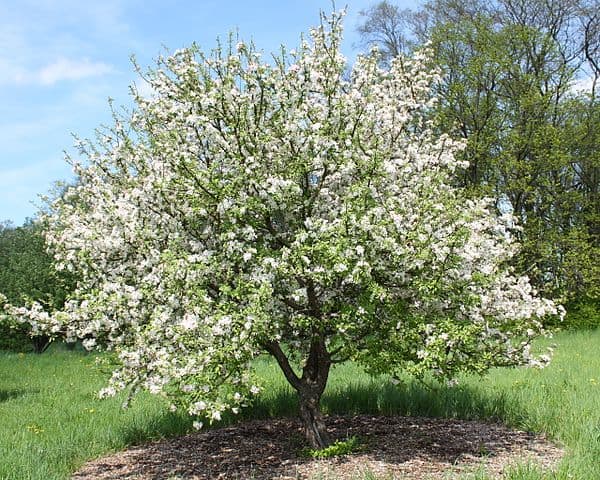

Storage and processing
Apples of this variety are grown not only in private farms for personal needs, but also on an industrial scale. The harvest is wonderfully stored. If you put it in a refrigerator or a special room for storage, where the temperature will not rise above +3 degrees, and the humidity will remain at the level of 85-95 percent, then such conditions will slow down the ripening of the fruits, and they will last until spring in the same state as they were ripped off. If the temperature is higher, the ripening process will not stop, the apples will become softer, the spotting characteristic of this particular variety (dark bitter spots on the skin) may appear. But they will still remain until February.
The fruits of "Jonathan" are universal in use - they are eaten fresh, canned, used in the preparation of table wines, wonderful preserves, jams, marmalades, juices and purees are prepared from them. They are very tasty as fillings for pies, they are involved in the preparation of sauces. All this is due to the large amount of sugars and the delicate structure of the fruit.
What are the fruits
Jonathan's apples are characterized by an excellent presentation and excellent taste:
- apple size - medium and large. Weight ranges from 100 to 160 g;
- the shape of the fruit is round or round-conical. Surface - smooth and even with practically no ribs, or there are subtle ribs;
- the main color of ripe apples is yellow-green. From above, the fruit is almost completely covered with a blurred or striped dark pink or red blush. Numerous white specks are visible on the surface of the fruit;
- the fruits have a juicy and tender creamy dense pulp, characterized by a sweet taste with a wine tint. There is a slight sourness in the taste.
pulp (100 g) contains the following components:
- sugars - about 11%;
- acids - 0.7%;
- vitamin C - 6 mg;
- active substances - 100 mg;
- dry components - no more than 14%.
The taste is rated at 4.5 points out of five existing ones.
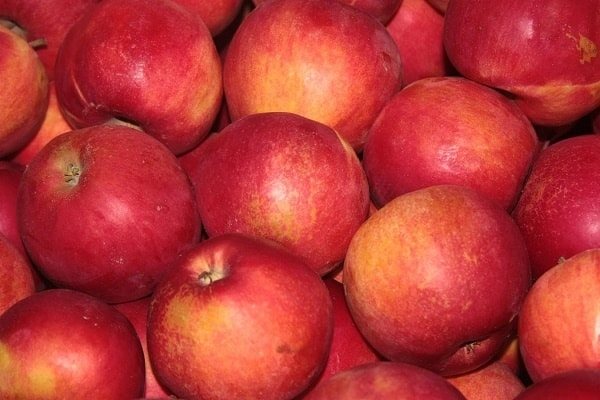

The benefits of apples Jonathan
The apples of this hybrid are a storehouse of useful substances for our health. They contain a huge amount of vitamins and minerals that have a beneficial effect on the human body. Jonathan's fruit pulp is rich in:
- vitamins A, groups B, C, E, P, PP, K;
- micro- and macroelements S, Cu, P, Na, K, Al, F, Fe, Ni, Mn, Cr, Mg, Zn, B, I, etc .;
- starch;
- pectin;
- fiber;
- folic acid;
- organic acids;
- tannins;
- antioxidants, etc.
Fresh they are used for:
- anemia;
- obesity;
- violation of metabolic processes;
- weakened immunity;
- blood diseases;
- violations of the cardiovascular system;
- diabetes mellitus;
- avitaminosis;
- kidney disease;
- arthritis and gout;
- diseases of the thyroid gland, etc.
Daily consumption of fresh fruit will cleanse the intestines and blood vessels, get rid of toxins, toxins, heavy metals, restore metabolism, and normalize cholesterol and blood sugar levels. Apples, in combination with various diets, will quickly get rid of those extra pounds.
Application
The hybrid fruit is incredibly tasty. They are eaten fresh. Various homemade preparations are made from apples - jam, jam, compote, marmalade, mashed potatoes, juice, jam, etc. They are added to desserts. Jonathan fruit is ideal for home winemaking.
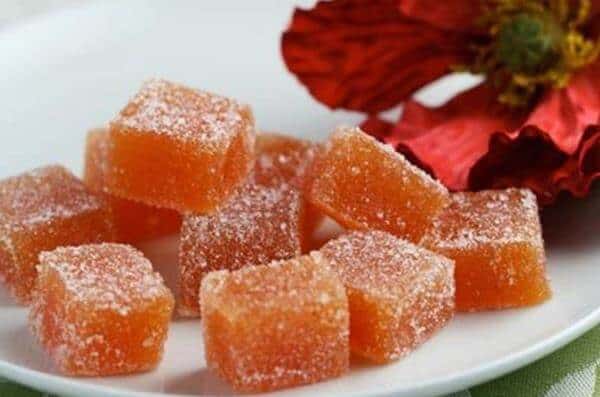

When ripe
The beginning of fruit ripening occurs in late August and early September. The massive ripening process takes place in mid-September. It is then that you can start harvesting.
Yield indicator
Productivity depends on the age of the tree - the older the apple tree, the more apples it gives. From apple trees over 12 years old, an average of 85 kg of fruit is harvested. But this is not the limit. With quality care, this figure can be increased many times.
Resistant to climatic conditions
Apple trees Jonathan have a weak winter hardiness. They do not take root in latitudes with harsh winters. During cold weather, wood and fruit shoots freeze. The level of drought resistance of trees is medium. Also, the hybrid does not tolerate cool and humid summers very well - there is a risk of contracting fungal diseases.
Storage times and transportability
In special fruit storage facilities, the fruits of the hybrid are stored until May. If the storage conditions are violated, apples can wither and become covered with putrefactive spots. Jonathan fruit perfectly tolerates transportation, due to which, basically, this type of fruit crop is grown on a massive scale.
"Jonathan" in the history of breeding
In domestic and foreign selection of fruit crops, this apple variety is one of the most popular. He is the "ancestor" of almost four dozen modern varieties, including the domestic "Kandil Orlovsky" and the American "Idared". The donor properties of "Jonathan" were successfully used by Canadian and French specialists in the development of "McFree" and "Florina", which are resistant to scab.
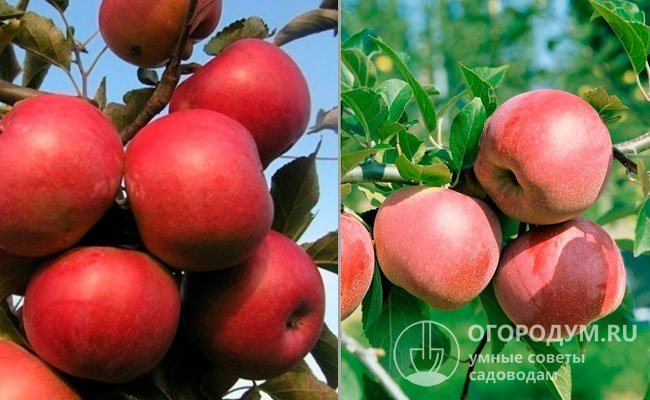

In the photo - apple trees "Idared" (left) and "Florina" (right), created using the genetic material of the variety
In addition to the English name, "Jonathan" has Russian names: "Horoshavka winter" and "Winter red". These apples are known to Ukrainian gardeners as "Oslamovskie" - by the name of the volost in the Podolsk province, where this variety has long yielded rich harvests.
Versions of the origin of the variety
There are two versions of the origin of this apple tree. The first connects its origin with the story of a certain Rachel Higley, who found apple seeds near a cider plant (Connecticut, USA) and planted them in Ohio in 1796. The trees that grew, Rachel named after her husband Jonathan.
The second version is historically more reliable: in 1886 the future the variety was selected from the apple seedlings "Aesop Spitzenburg" (Esopus Spitzenburg) grown on Philip Rick's farm in Woodstock, Ulster County, New York. The apple trees were probably originally called "Rick," after the owner of the farm. This variety was named "Jonathan" later - in honor of the American gardener J. Zander, who drew attention to the emergence of a new apple variety with improved characteristics.
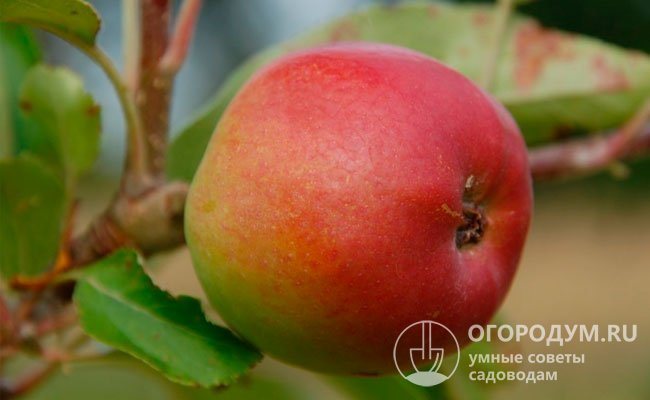

In the photo - the apple tree "Aesop Spitzenburg", from which, according to many experts, as a result of free pollination, the variety originated
Disease protection
Jonathan trees are almost never affected by scab, but their scourge is powdery mildew, from which preventive treatment of plants in early spring with Bordeaux mixture, colloidal sulfur, and fungicides Topaz, Skor, Tiovit Jet, Impact saves. Sometimes apple trees can be affected by:
- moniliosis;
- cytosporosis;
- black cancer.
Moniliosis of the apple tree is practically incurable. If a tree is sick, then it is better to destroy it, and in order to prevent disease, the plants must be treated annually before flowering with a Bordeaux mixture or a solution of copper sulfate.
Autumn feeding of apple trees with potassium and phosphorus will save from cytosporosis. In the spring, the trees are sprayed with copper-containing fungicides.
A reliable protection against black cancer is the treatment of the roots of seedlings before planting with a solution of copper sulfate. Also apple trees need spring treatment with Bordeaux liquid. If the ailment made itself felt, then the following measures are applied - cut off the affected areas, clean them, lubricate them with a solution of copper sulfate and seal them up with garden pitch.
As a protection against pests, plants are treated every spring and autumn with special insecticides, such as Karbofos, Aktara, Iskra-M, etc.
Powdery mildew on an apple tree.
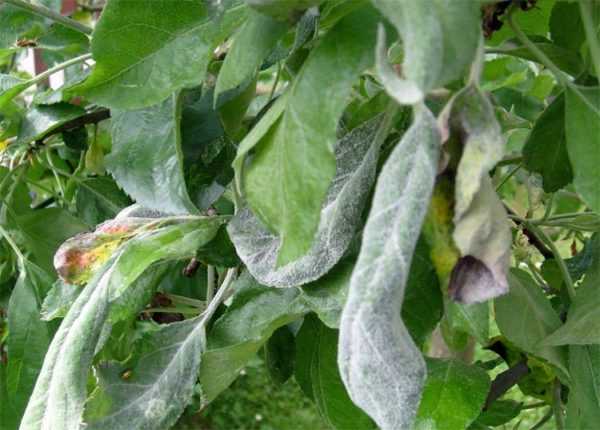

Diseases and pests
There is a high risk of being affected by several diseases, except for scab, so the tree must be treated with fungicides.
- For powdery mildew, which manifests itself in the form of a whitish oily coating on flowers, leaves and young growth, Bordeaux liquid, Topaz, Skor or Hom is used.
- Bacterial cancer leads to massive darkening and drying of the leaves, then wood cracking. In treatment, antimicrobial drugs from a number of penicillins are used. 1 ampoule of the substance is dissolved in 10 l of water. Irrigate every 20 days until complete recovery. If this does not help, the tree should be dug up, burned, and the place of growth should be spilled with a solution of copper sulfate or Bordeaux liquid.
Also, an apple tree can be attacked by various harmful insects - aphids, flower beetle, moth, hawthorn and caterpillars. For protection and treatment, insecticides are used - Karbofos, Fitoverm or Actellik. Irrigation is carried out three times per season - in early spring, before and after flowering.
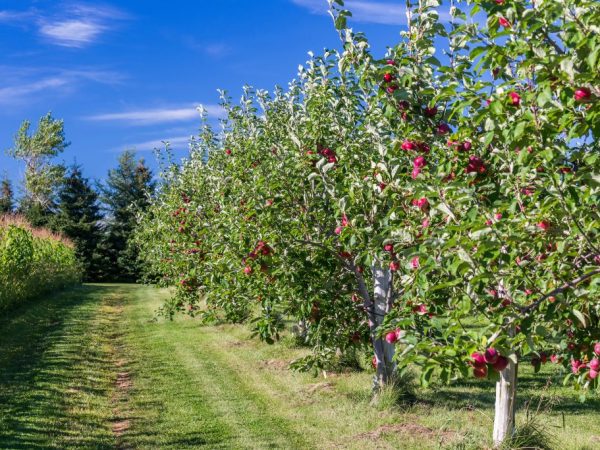

Apple trees need proper care
To avoid infection, several important rules must be followed in growing:
- buy healthy seedlings;
- plant them according to a certain pattern;
- regularly cut off diseased parts on a tree, water, fertilize;
- to maintain cleanliness in the garden - every fall, dig up, remove and burn carrion, fallen leaves.
Growing
Growing a healthy apple tree is not so difficult if you are responsible for the choice of seedlings and planting sites, as well as provide fruit trees with quality care.
The choice of planting material
The safest way is to purchase seedlings from nurseries or specialized outlets. When buying seedlings, you need to pay attention to their appearance and the condition of the root system. It is best to take strong, healthy two-year-old seedlings with well-developed roots.
Choosing a place for an apple tree
A place for a tree is chosen in an open space, well-lit by the sun, where the occurrence of groundwater is far from the earth's surface. The soil on the site must be fertile.If this is not the case, then when preparing the place for the apple tree, nutrients are added.
Landing
The tree planting rules are simple:
- in a couple of weeks, the site is dug up, the soil is cleared of weeds and fertilized;
- then they dig holes to a depth of 80 cm, about a meter wide, which are filled with a mixture of nutrient soil with fertilizer;
- seedlings are placed in the holes, buried, tamped, watered and mulched.
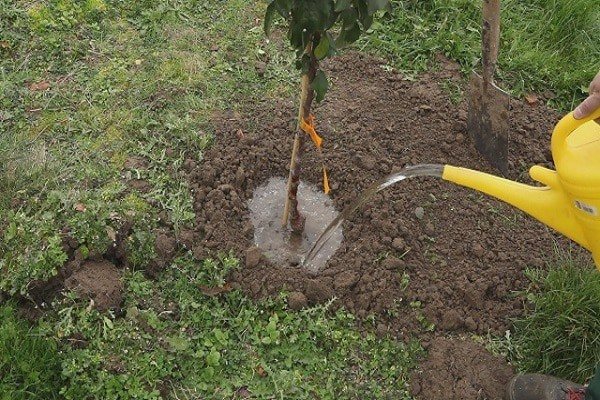

How to care
Care consists in:
- watering;
- dressing;
- pruning;
- weeding and loosening;
- treatment against diseases and pests;
- preparing for winter.
The choice of planting material
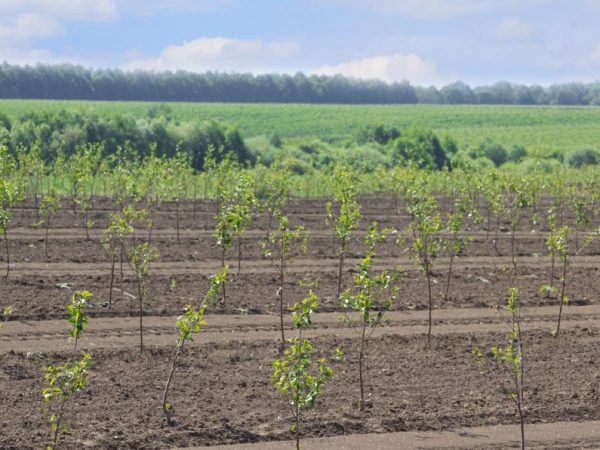

Prepare seedlings for planting
You can buy seedlings in a gardening nursery, where you will probably be provided with a real plant with all varietal characteristics and qualities.
Choose grown specimens - at least 80 cm high, 1-2 years old and with a closed root system. They have a good survival rate.
You can determine the freshness and health of an apple tree by the state of its crown:
- shoots are elastic, without mechanical injuries and signs of infection with diseases - mold, spots of brown, black or reddish tones, growths;
- leaves and buds are fresh, juicy, saturated green, do not crumble when shaking off the crown.
Before planting, the rhizome must be soaked in cold water with the addition of one of the root growth stimulants for 10 hours. Then process with a clay mash.
Description of the variety Jonathan
Consider separately the appearance of the apple tree and the fruit.
The size of mature trees is medium, the crown has a round rather wide shape, spreading. The branches branch off from the trunk at an obtuse angle, the crown density is average.
Branches under the weight of ripe fruits usually bent downward. Leaves are medium in size, slightly wavy at the edges, the leaf surface is dull. The dense pubescence of the leaves gives the crown a bluish tint.
Fruits from medium-sized, smooth, glossy skin. The average weight of an apple is 100 - 150 grams. The main color of the skin is green, the blush is deep red and sometimes covers the entire surface of the fruit.
The skin is very thin, but dense and protects the fruit well from mechanical damage. Apples retain their attractive appearance for a long time and are easy to transport.
The pulp during the harvest period is white with a greenish tinge, in ripe apples it is light yellow. Sourness is almost indistinguishable in a delicate and sweet taste.
On a 5-point taste scale, Jonathan scores 4.5 points. Apples are good both fresh and for making compotes and jams. On an industrial scale, they are more often used to obtain powder raw materials and as a wine material.
> Photo
Yield
Apple trees are fast-growing, yield in 6 years, rarely 4-5. Ties about a third of the fruits (with free pollination). The yield is growing every year; young apple trees give about 20 kg of fruit.
Trees that have reached the age of 10 years or more give an annual yield of 30-40 kilograms.
Some specimens beat a record with a yield of 300 - 400 kg!
Harvest time is from mid-September to mid-October. Jonathan's apples can be stored until March, provided they are stored in special cellars, but they often stop loose and become covered with a spotty, bitter bloom.
Jonathan is kept in the refrigerator until mid-May.
The optimum storage temperature is 2-3 degrees above zero.
It is better to store apples in pallets, which are moistened before being sent to the refrigerator.
With a humidity of 90 -95%, the fruits remain juicy and do not lose the elasticity of the skin.
The higher the storage temperature, the sooner the fruit will ripen, so if you want to keep the apples until spring, choose cold storage.
If apples are to ripen by winter or early spring, storage outside the refrigerator compartment in special pallets is possible.
Testimonials
Estimates for the variety come from its long history of cultivation in many regions:
- Excellent apples.
- Weak tree.
Rostislav. “If you choose the five best apples, then Jonathan will definitely be included in it. I'm not talking about his entire family. I bought them on the market for many years. I searched and planted in my garden. I waited 4 years. And now every year I collect 3-4 buckets of good apples for storage in the winter. I don't see any Jonathan disease. Because of their excellent taste, they do not last until then. We eat with pleasure. And we treat our friends. "
Regina Dubtsova. “Have succumbed to the general psychosis about Jonathan's lovely apples. They also planted them in their own garden. They did not cheat with the variety. But no one warned about the problems with the apple tree. The tree is vigorous. Until I shortened the growth by pruning, I did not see normal apples - 15-20 pieces and that's it. And those are not quite high quality. It is imperative to treat diseases with fungicides 2-3 times. "
Konstantin. "Apples taste great. Can't be confused with others. You just have to be ready to grow apples. Instead of waiting for them to grow up themselves. But if you have a system in the fight against diseases, an annual 3-4 treatments with fungicides and against pests are enough. And top dressing helps the tree to resist disease. By the way, there is no more attention than other winter varieties. This is from a very young age. You will have at least 6-8 buckets of these apples for the winter. "
Irina. "The apple variety Jonathan is very popular with the whole family. The apple tree has been growing for over 10 years. And something is wrong with her. Maybe I'm doing something wrong. Tell me the rules of leaving. "
Planting and leaving
The variety is perfect for growing in a private garden as well as for mass planting of commercial use.
Before planting an apple tree of this variety in your area, make sure that the climate in your area is sufficiently mild.
Winters with temperatures below -15 degrees will be unfavorable for non-frost-resistant plants.
In the northern regions, the harvest period will shift from September to the end of September.
It is better to buy Jonathan seedlings in special nurseries.
The optimum seedling size is 80 centimeters.
The best time to plant is spring, but not earlier than mid to late April.
Apple tree Jonathan Gold, when planting, is planted at a distance of 3 meters from each other.
Young seedlings need protection from the scorching sun and wind - shade them with branches or cloth.
The tree develops well with enough sunlight, does not like shading. The soil is preferable loamy or sandy loam.
If you plan on harvesting bountiful crops from your apple tree, make sure the soil is fresh. On poor soil, apples will shrink and stick poorly on the branches.
If the land on which Jonathan grows is not fertile enough, fertilizing is necessary. During droughts, additional watering is required.
Spring pruning of apple trees is required. Prune apple trees purchased from the nursery only in the second year.
Breeding history
Apple variety Jonathan owes its appearance to the selection of American scientists in the 1880s. The selection was based on the seedlings of the Aesop Spitzenburg varieties. According to one of the theories, Rachel Hingley developed this variety and gave it the name of her husband - Jonathan. Also, these apples are known under the names: apple-tree Jonotanovy tree, Winter red or Horoshavka winter.
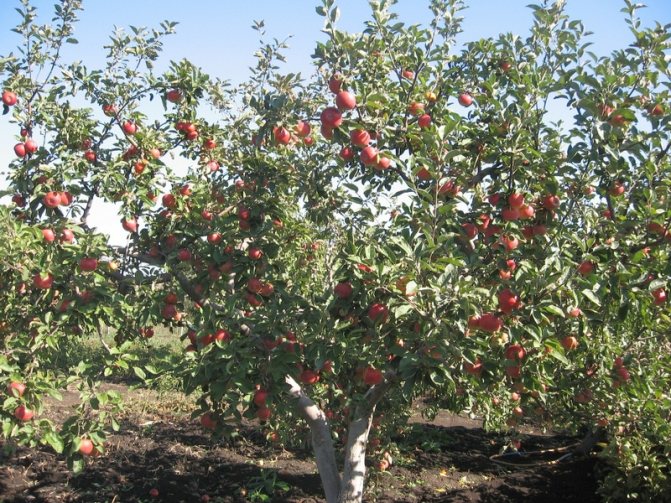

Apple Trees Jonathan
Initial breeding experiments took place in Ohio (USA). The climate in the state is mild, the temperature in winter rarely drops below -1 ° C degrees. Since the 1950s, apple trees have become widespread on the territory of Ukraine, while in the Russian Federation they are found only in the North Caucasus, where the climate is milder. Such a territorial distribution is due to the low resistance of the variety to subzero temperatures.

